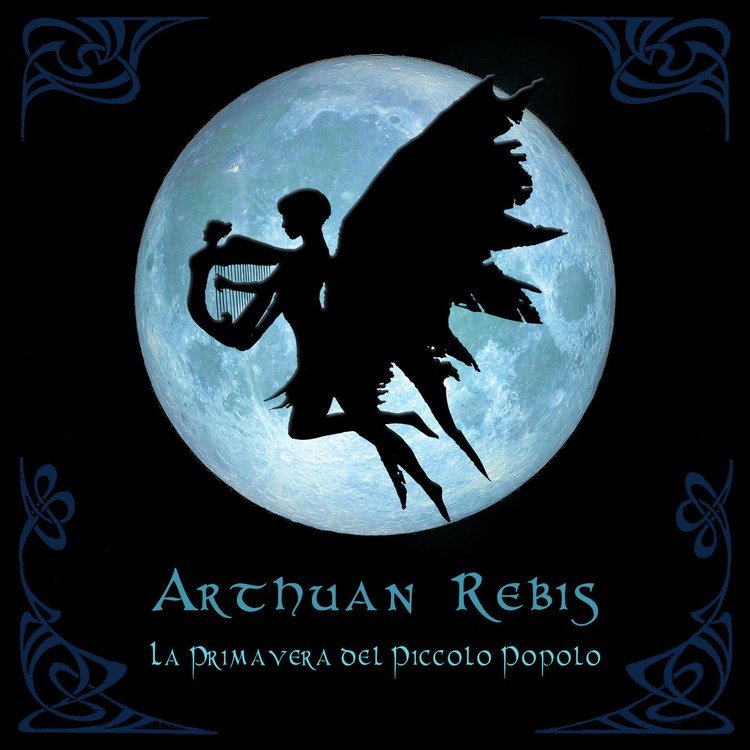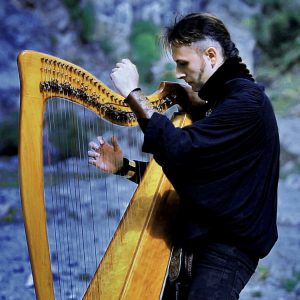
Always quit while you’re ahead! Well, the Dutch folk band
Finvarra
took this old saying literally, announcing that the band would stop playing together in the very same message in which they talked about the release of their latest mini-CD. That is one way to get my attention. In the words of the band:
“- We are and will remain good friends but in the last two years we all went our own (musical) ways and we are happy with that. We had a very nice time with the band and are proud of all we have achieved, the great concerts we gave, all the nice people we’ve met and of the two CD’s we have released. We would like to thank the bookers who put their faith in us and made concerts possible on the most adventurous locations. And of course we thank the photographers who captured these concerts so we could share them with the world. Last but not least, we would very much like to thank YOU, our loyal fans, for your support, love, and for dancing to our off-count songs 😉. Here’s to friendship and music!!”
So
Lanterne is not only Finvarra latest CD, no it is also the last album the band will make together. And yes just as you, I secretly – as secret as you can be writing it out right here- hope there will be a reunion somewhere in the future. Listening to the quality of music on the record, I am left craving for more. A lot more!

But let me introduce the band first. Finvarra are the Dutch musicians Dieke Elfring (vocals, bodhrán, percussion); Gwendolyn Snowdon (vocals, Indian harmonium, bouzouki); Patrick Broekema (guitar, bouzouki, mandolin, low whistle, backing vocals); Corné van Woerdekom (violin, backing vocals, percussion) and Evert Willemstijn (double bass). Their origins go way back to 2010 when Dieke and Corne, both studying at Leiden University, met Patrick and Gwendolyn at folk sessions held every two weeks in Cafe the Tregter in Leiden at the time. (Sessions that owner Marius van der Ploeg kept organizing until 2017 when he finally retired after 25 years.) The four band members found each other in their love of Celtic folk, but from the very start were not afraid to incorporate new styles and instruments.
You could say the band was an instant hit in the folk scene, playing on the
Folk Battle finals and at the
Midwinter Fair
both in 2011, only a year after their first official band picture was published. Followed by
Summer Darkness
in 2012 and 2013, the Gothic & Fantasy Fair in Rijswijk 2013 (now known as the
Fantasy Fest) ,
Keltfest and
Elfia,
Arcen in 2014 and to top it all off their first
Castlefest in 2015!
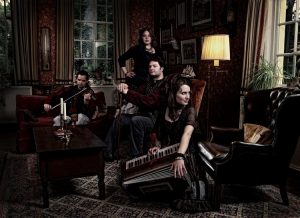
In 2013 Finvarra released their first album, simply called
Finvarra, filled with eleven lovely European
folk songs. European, because the band combined well known Celtic folk traditionals like
The Well Below
The Valley and
The Cliffs Of Moher, with more Balkan influenced songs like
The Wind That Shakes The Barley or
Jovano Jovanke/Ciuleanda, and even their own interpretation of that famous
Led Zeppelin
song:
The Battle Of Evermore.
In 2017 the band announced they would be back in the studio, and then it went rather quiet around Finvarra. A silence that was suddenly broken early this year with the message I quoted above, announcing both the birth of the new album and the end of Finvarra as a band.
Lanterne starts as a warm blanket. The first song
Banks of The Edisto is a touching ballad, featuring not only Dieke’s warm, slightly jazzy vocals, but also Patrick’s pleasant guitar and Corné’s lovely violin solos. The original is by the American folk singer-songwriter
Dayna Kurtz,
recorded on her 2006 album
Another Black Feather…For The Wings Of A Sinner.
(An album well worth listening to if you love American folk music, with touches of jazz, Americana, and the occasional influences of raw 60’s protest songs, but I digress.) Dayna Kurtz recorded Banks Of The Edisto as a ‘small’ banjo and vocal ballad, Finvarra made it sound much richer, more orchestral and gave the song a real Celtic folk feel. Both, I have to say, are lovely versions.
With
Finvarra’s Song, we keep that strong Celtic orchestral feel. Finvarra, together with
Alain Labrie (also known for his flamenco band
Labryénco),
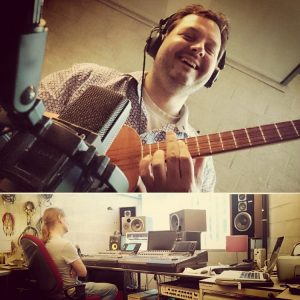
who recorded and produced the album, really managed to give
Lanterne an overall wonderful and rich sound, very cleverly working with stereo effects and delicate touches of musical decorations at unexpected places to achieve that. Gwendolyn’s powerful welsh folk voice cuts right through all this richness, creating a wonderful contrast within the song that makes it even more powerful.
Listening carefully I can’t help spotting the slightly Spanish sounding acoustic guitar chords, some Mediterranean flavours crawling in or the clear Eastern European violin solos spicing up this Celtic folk song. Something that clearly continues on the instrumental
A Bruxa/Flatbush Waltz. The guitar and violin melodies lead my mind to a place somewhere between northern France and Andalusia. On a warm evening under a star-filled sky.
This is actually the main difference between this record and Finvarra’s first album. On the first CD, the different influences were clearly divided over single songs Some sounding Celtic, some French, and some clearly eastern orientated. On Finvarra’s latest record all those influences have gelled together into one single sound, making
Lanterne sound much more coherent. Another difference is the lead role Dieke took as a singer. Besides
Banks Of The Edisto she also sings the lead on the Spanish sounding
True Unfaithful Love and the absolutely beautiful ballad
Motherland, a true gemstone in my opinion. Easily one of my favourite songs on
Lanterne. Dieke’s low, warm and jazzy voice works SO well with the European folk style Finvarra is now playing. listening to this I can’t help but hope that somewhere in the future Finvarra will come together one more time, either to play live for us all or even to record new music. The way the musicians fit together in these songs is pure magic.
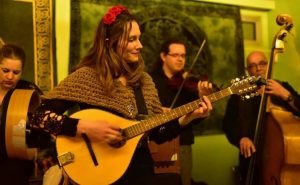
The instrumental
Whiskey & Ouzo tells it all actually. On
Lanterne Finvarra successfully blends the Celtic world with the Mediterranean, giving true meaning to the term European folk.
I have nothing more to say really, this is a must-have album for all who love folk music. It is as simple as that. Still hesitating? Put on the title song
Lanterne and let Gwendolyn win you over herself. Another wonderful song on a wonderful record of a wonderful band.
It is so sad to see them go, but I am so happy they leave us while they are ahead. Best giving away present I have had in a loooooong time.
– Cliff
editor:
– Anna Schürmann
pictures:
–
Eline spek, early band picture (2010)
–
Duane Teske, official band photo (2013)
– Finvarra studio picture
– Finvarra

 The title song Aether still sounds like The Moon and the Nightspirit as we know it from their previous records. The lovely soundscape to start it off; the subtle guitar notes; the rich and ancient sound of the dulcimer; the typical vocals of Ágnes (combining the innocence of a child with the ancient wisdom of a forest elf in her voice), the haunted violin chords, it is all so typical, all so beautiful, all so unmistakably The Moon and the Nightspirit. Within minutes I’m drawn into the song, drawn into the CD actually. The captivating power of The Moon and the Nightspirits’music is all because of the writing skills of Ágnes and Mihály, the ingenious way these talented musicians build-up their songs. It is never rushed, never forced. It feels like the music is growing organically; like it is born from within itself, these notes were always there in the mists of time, waiting to be found by those who dared to listen; and now it is found. Now it is recorded, and all I want to do is close my eyes, listen, feel, absorb it all and let go, let myself get swept away by it all. Gliding in the essence of Aether. This is just the first song and I already know this is one of the best albums I’ve heard this year!
It is on the second song Kaputlan Kapukon Át, that we hear The Moon and the Nightspirits’ male side for the first time. And well, I LOVE it. Truly love it. Ágnes and Mihály have added an electronic feel to their music that is very similar to the sound
Guido Bergman
added to
Shireen.
Placing the music of The Moon and the Nightspirit slap-bang in the middle of three of my all-time favourite bands: Shireen, The Moon and the Nightspirit themselves, and the gothic/dream-pop duo
Cranes.
It is all so beautiful I find it hard to describe. Where do I start? It is that power of the low keyboard sound – sounding like an electrified version of a mouth harp/slidgeridoo combination – driving and driving the song; it’s those fragile, eerie vocals of Ágnes, tender, breakable and oooooh so enticing; it is the flow of the music, coming and going, like waves of gothic power building up and crashing into the acoustic medieval coral-like intermezzos in between. For those who love gothic medieval rock, this is a masterpiece. A true masterpiece. The only downside is that the song slowly fades out waaaay before I want it to end. Even tho it clocks in at 6:37 it feels like an instant. This is a song I want to last forever and ever, even longer if in any way possible.
Luckily it is not the end of the album….Nooo we still have 5 more gems to come. Égi Messzeségek is next. Again there is that electric drone, that sampled mouth harp drawing me deep, deep into the mystical world of The Moon and the Nightspirit. Take the sound of Shireen; the sound of
Dead Can Dance
on Aion;
the feel of the Cranes dark masterpieces Adoration or Thursday of their debut album Wings of Joy; add Faber Horbach’s
(Sowulo)
spoken scream vocals on Mann; add a Sophie ‘Shireen’ Zaaijer-like violin solo and you have the new sound of The Moon and the Nightspirit on Égi Messzeségek. Now honestly, what is not to love about that?
Do I need to go on? Do I need to mention A Szárny; the pure gothic rock drum sound in it; the layer upon layer of dark musical silk making this music so strong, sooo powerful, sooooo beautiful. The clever thing is that: with every next song on Aether, the band adds a new element to it. You are guided into their new sound. Guided from the old feminine, medieval folk music of earlier records into these new masculine soundscapes. Clever; so clever.
The title song Aether still sounds like The Moon and the Nightspirit as we know it from their previous records. The lovely soundscape to start it off; the subtle guitar notes; the rich and ancient sound of the dulcimer; the typical vocals of Ágnes (combining the innocence of a child with the ancient wisdom of a forest elf in her voice), the haunted violin chords, it is all so typical, all so beautiful, all so unmistakably The Moon and the Nightspirit. Within minutes I’m drawn into the song, drawn into the CD actually. The captivating power of The Moon and the Nightspirits’music is all because of the writing skills of Ágnes and Mihály, the ingenious way these talented musicians build-up their songs. It is never rushed, never forced. It feels like the music is growing organically; like it is born from within itself, these notes were always there in the mists of time, waiting to be found by those who dared to listen; and now it is found. Now it is recorded, and all I want to do is close my eyes, listen, feel, absorb it all and let go, let myself get swept away by it all. Gliding in the essence of Aether. This is just the first song and I already know this is one of the best albums I’ve heard this year!
It is on the second song Kaputlan Kapukon Át, that we hear The Moon and the Nightspirits’ male side for the first time. And well, I LOVE it. Truly love it. Ágnes and Mihály have added an electronic feel to their music that is very similar to the sound
Guido Bergman
added to
Shireen.
Placing the music of The Moon and the Nightspirit slap-bang in the middle of three of my all-time favourite bands: Shireen, The Moon and the Nightspirit themselves, and the gothic/dream-pop duo
Cranes.
It is all so beautiful I find it hard to describe. Where do I start? It is that power of the low keyboard sound – sounding like an electrified version of a mouth harp/slidgeridoo combination – driving and driving the song; it’s those fragile, eerie vocals of Ágnes, tender, breakable and oooooh so enticing; it is the flow of the music, coming and going, like waves of gothic power building up and crashing into the acoustic medieval coral-like intermezzos in between. For those who love gothic medieval rock, this is a masterpiece. A true masterpiece. The only downside is that the song slowly fades out waaaay before I want it to end. Even tho it clocks in at 6:37 it feels like an instant. This is a song I want to last forever and ever, even longer if in any way possible.
Luckily it is not the end of the album….Nooo we still have 5 more gems to come. Égi Messzeségek is next. Again there is that electric drone, that sampled mouth harp drawing me deep, deep into the mystical world of The Moon and the Nightspirit. Take the sound of Shireen; the sound of
Dead Can Dance
on Aion;
the feel of the Cranes dark masterpieces Adoration or Thursday of their debut album Wings of Joy; add Faber Horbach’s
(Sowulo)
spoken scream vocals on Mann; add a Sophie ‘Shireen’ Zaaijer-like violin solo and you have the new sound of The Moon and the Nightspirit on Égi Messzeségek. Now honestly, what is not to love about that?
Do I need to go on? Do I need to mention A Szárny; the pure gothic rock drum sound in it; the layer upon layer of dark musical silk making this music so strong, sooo powerful, sooooo beautiful. The clever thing is that: with every next song on Aether, the band adds a new element to it. You are guided into their new sound. Guided from the old feminine, medieval folk music of earlier records into these new masculine soundscapes. Clever; so clever.
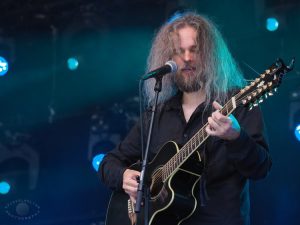 Logos starts gently again; reminiscent of
Priscilla Hernandez‘s
Ancient Shadows album. It gives us a moment to breathe after the intense journey we just had. It is also proof that The Moon and The Nightspirit didn’t lose their soft side. No, they just added to it. Boy did they add to it! Don’t sit and wonder too long cause A Mindenség Hívása is coming, and the drum fills are ready to grab you, take you down in a bliss of musical adoration again.
My conclusion can be short but sweet. This is the best album I heard in 2020. And yes I am biased, as I have been a fan of gothic music ever since its origins at the end of the ’70s. Hearing Aether for the first time truly had the same effect on me as hearing
the Sisters of Mercy
for the very first time. Or a musically better comparison
Siouxsie and the Banshees.
Two bands I adore. Just as their music 40 odd years ago, Aether just blew me away from the very first note! The cool thing is The Moon and the Nightspirit added their own uniqueness to the gothic style. Yes, it has this dark power of the early goth bands, but just as Shireen, they added sooo many more layers to it. This music oozes richness, it oozes velvety dark chocolate out of every note played; velvety-dark and bittersweet; beautifully soft; intensely strong. Aether opens the door to the dark elf lands existing in the twilight of our imagination. This is NOT a normal album; produced, composed, written, and arranged, no no no no! This is a living, breathing musical entity, lying dormant in the Aether of time, sleeping amongst the night spirits, waiting to finally appear…. and I truly, truly love it!
– Cliff
Editor: Sara
Cover art: Ágnes Tóth
pictures: Spiegelwelten photography
Logos starts gently again; reminiscent of
Priscilla Hernandez‘s
Ancient Shadows album. It gives us a moment to breathe after the intense journey we just had. It is also proof that The Moon and The Nightspirit didn’t lose their soft side. No, they just added to it. Boy did they add to it! Don’t sit and wonder too long cause A Mindenség Hívása is coming, and the drum fills are ready to grab you, take you down in a bliss of musical adoration again.
My conclusion can be short but sweet. This is the best album I heard in 2020. And yes I am biased, as I have been a fan of gothic music ever since its origins at the end of the ’70s. Hearing Aether for the first time truly had the same effect on me as hearing
the Sisters of Mercy
for the very first time. Or a musically better comparison
Siouxsie and the Banshees.
Two bands I adore. Just as their music 40 odd years ago, Aether just blew me away from the very first note! The cool thing is The Moon and the Nightspirit added their own uniqueness to the gothic style. Yes, it has this dark power of the early goth bands, but just as Shireen, they added sooo many more layers to it. This music oozes richness, it oozes velvety dark chocolate out of every note played; velvety-dark and bittersweet; beautifully soft; intensely strong. Aether opens the door to the dark elf lands existing in the twilight of our imagination. This is NOT a normal album; produced, composed, written, and arranged, no no no no! This is a living, breathing musical entity, lying dormant in the Aether of time, sleeping amongst the night spirits, waiting to finally appear…. and I truly, truly love it!
– Cliff
Editor: Sara
Cover art: Ágnes Tóth
pictures: Spiegelwelten photography
